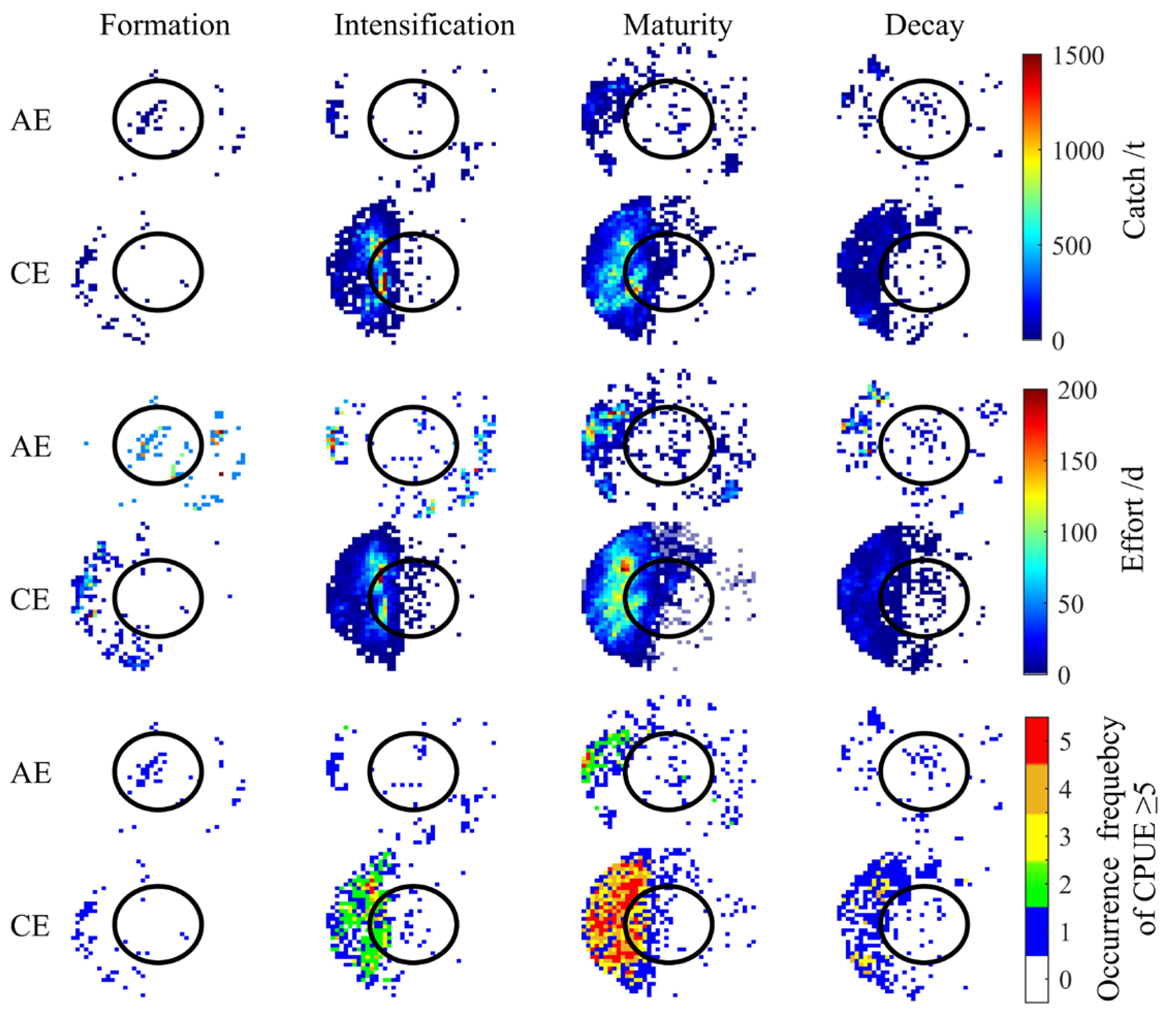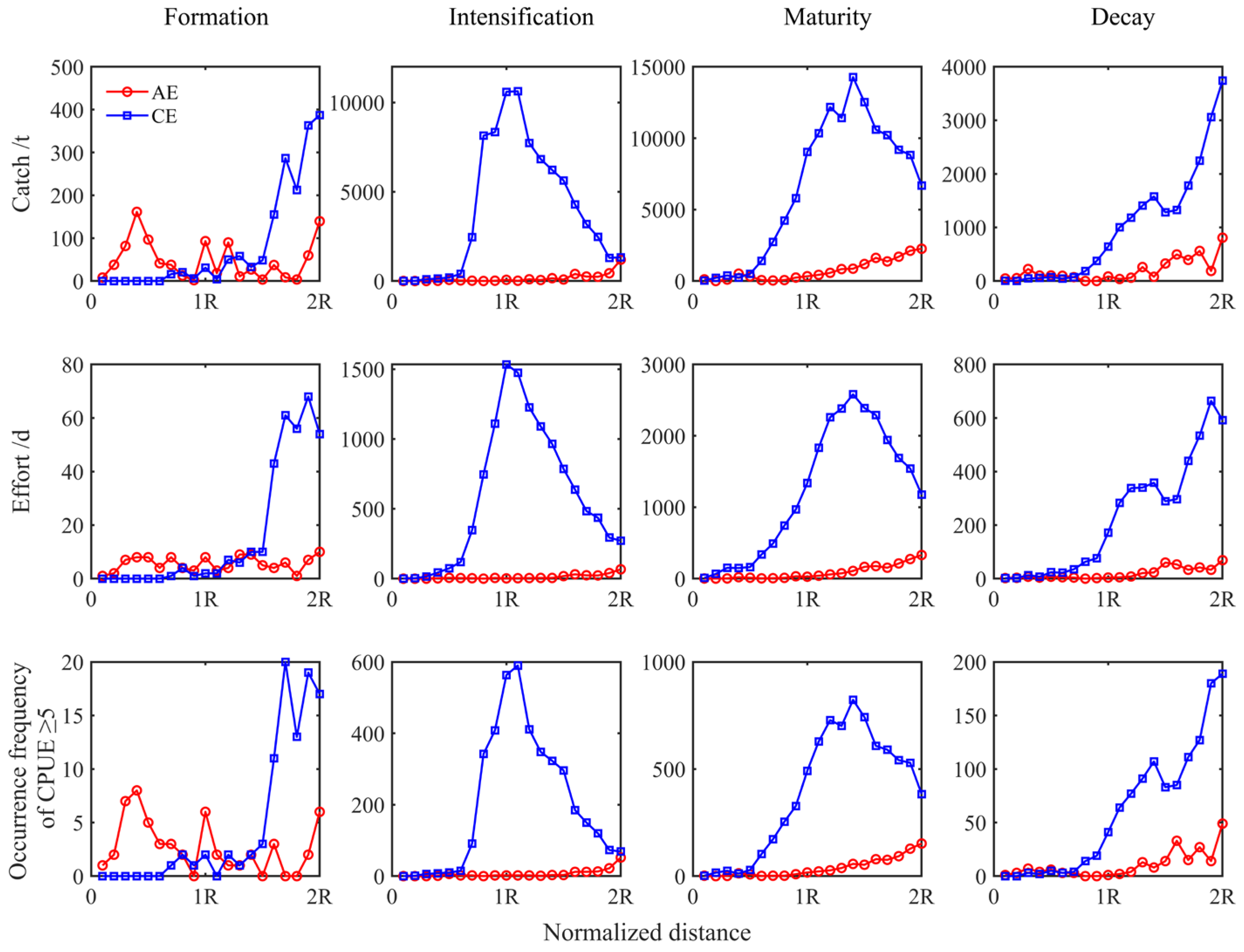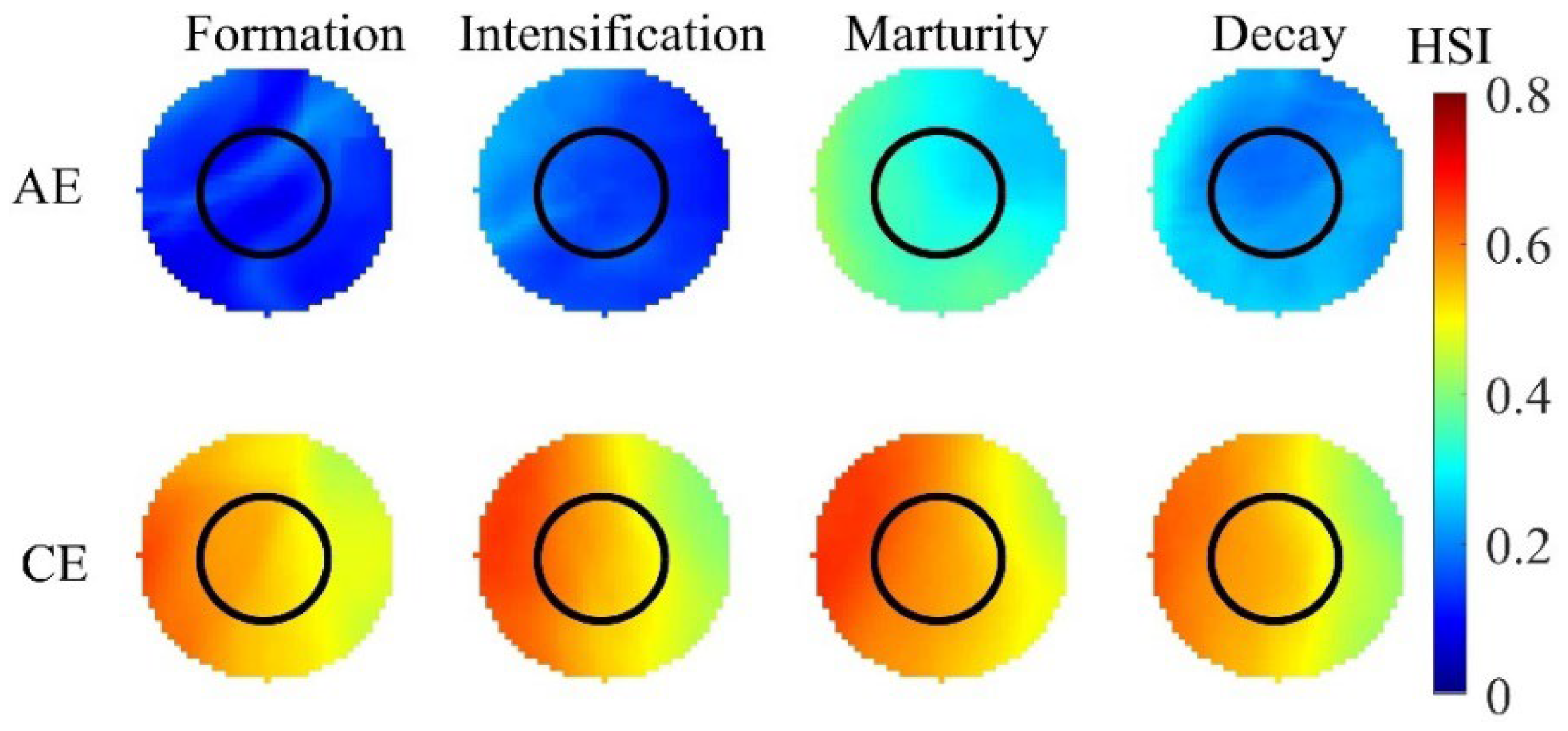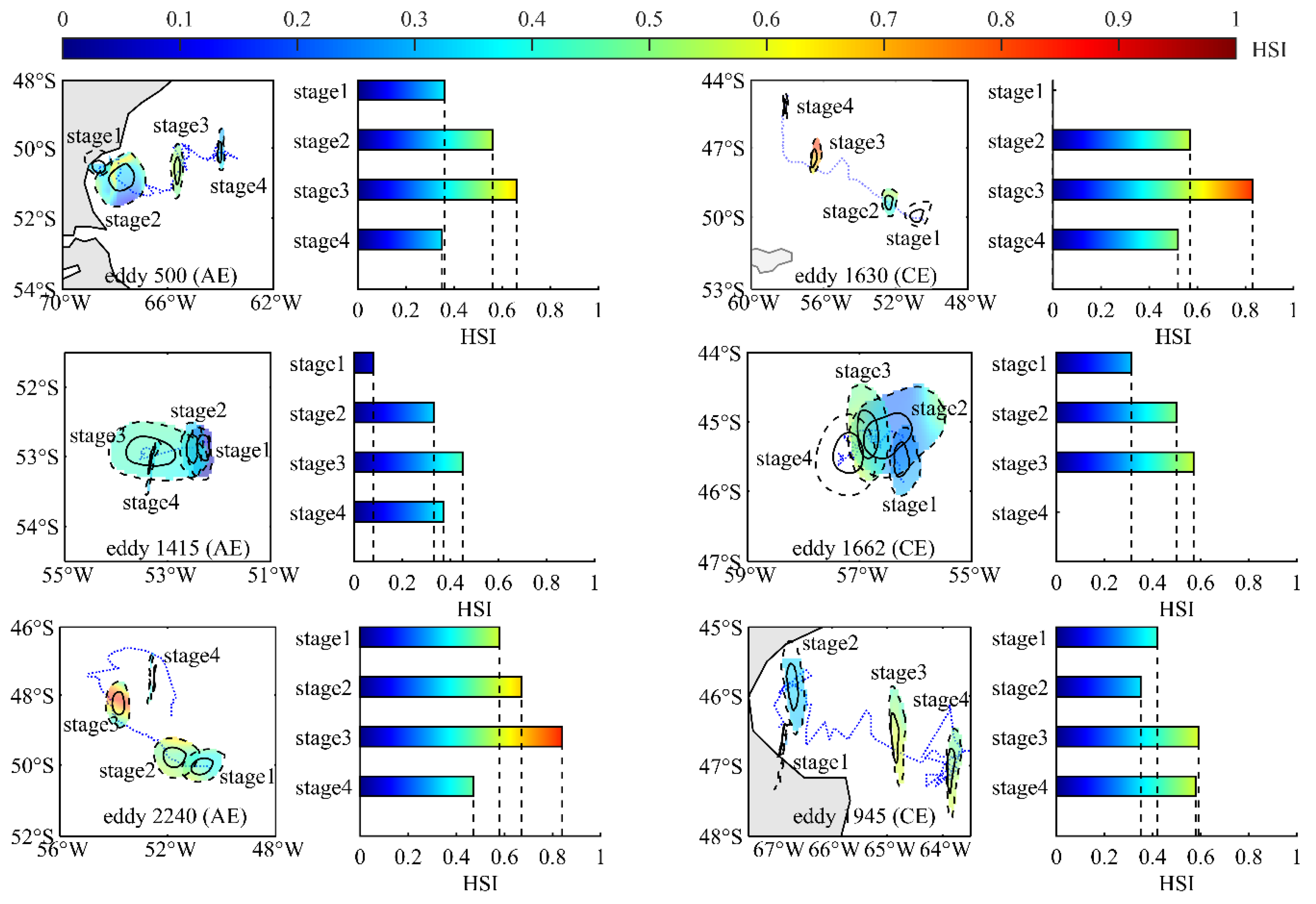Spatial Distribution of Illex argentinus in Different Life Stages of Mesoscale Eddies in Patagonian Waters
Abstract
1. Introduction
2. Materials and Methods
2.1. Fisheries Data
2.2. Environmental Data
2.3. Mesoscale Eddy Data
2.3.1. Relationship Between Squid Resource Abundance and Eddy Position
2.3.2. Environmental Variations Within Eddy Life Stages
2.3.3. Variations in Habitat Suitability Within Eddy Life Stages
2.4. The Effect of Eddy Evolution on Squid Habitat Suitability, Investigated Using Case Studies
3. Results
3.1. Variations in the Distribution and Abundance of I. argentinus Across Eddy Life Stages
3.2. Spatial Relationship Between Eddy Centers and CPUE Center of Gravity
3.3. Spatial Distribution Patterns of SST, T200m, and Chl-a Within Eddy Life Stages
3.4. Variations in SI and HSI Across Eddy Life Stages
3.5. Variations of HSI Across the Life Cycle of Six Eddies
4. Discussion
4.1. Environmental Changes Across Eddy Life Stages
4.2. Characteristics of I. argentinus Resources Across Eddy Life Stages
4.3. The Impact of Eddy Evolution on SI and HSI
5. Conclusions
Supplementary Materials
Author Contributions
Funding
Institutional Review Board Statement
Informed Consent Statement
Data Availability Statement
Conflicts of Interest
References
- Early, J.J.; Samelson, R.M.; Chelton, D.B. The evolution and propagation of quasigeostrophic ocean eddies. J. Phys. Oceanogr. 2011, 41, 1535–1555. [Google Scholar] [CrossRef]
- Zhang, Z.; Tian, J.; Qiu, B.; Zhao, W.; Chang, P.; Wu, D.; Wan, X. Observed 3D structure, generation, and dissipation of oceanic mesoscale eddies in the South China Sea. Sci. Rep. 2016, 6, 24349. [Google Scholar] [CrossRef] [PubMed]
- Renault, L.; Masson, S.; Oerder, V.; Jullien, S.; Colas, F. Disentangling the mesoscale ocean-atmosphere interactions. J. Geophys. Res. Ocean. 2019, 124, 2164–2178. [Google Scholar] [CrossRef]
- Chelton, D.B.; Schlax, M.G.; Samelson, R.M. Global observations of nonlinear mesoscale eddies. Prog. Oceanogr. 2011, 91, 167–216. [Google Scholar] [CrossRef]
- Garcia, C.A.E.; Sarma, Y.V.B.; Mata, M.M.; Garcia, V.M.T. Chlorophyll variability and eddies in the Brazil–Malvinas Confluence region. Deep Sea Res. Part II Top. Stud. Oceanogr. 2004, 51, 159–172. [Google Scholar] [CrossRef]
- Zhang, Y.C.; Wang, N.; Zhou, L.; Liu, K.F.; Wang, H.D. The surface and three-dimensional characteristics of mesoscale eddies: A review. Adv. Earth Sci. 2020, 35, 568–580. [Google Scholar] [CrossRef]
- Cabrera, M.; Santini, M.; Lima, L.; Carvalho, J.; Rosa, E.; Rodrigue, C.; Pezzi, L. The southwestern Atlantic Ocean mesoscale eddies: A review of their role in the air-sea interaction processes. J. Mar. Syst. 2022, 235, 103785. [Google Scholar] [CrossRef]
- Xing, Q.W.; Yu, H.Q.; Wang, H.; Ito, S.; Chai, F. Mesoscale eddies modulate the dynamics of human fishing activities in the global midlatitude ocean. Fish Fish. 2023, 24, 527–543. [Google Scholar] [CrossRef]
- Zhang, Y.C. The Effects of Mesoscale Eddies on the Abundance and Distribution of Neon Flyings Quid in the Northwest Pacific Ocean. Master’s Thesis, Shanghai Ocean University, Shanghai, China, 2023. [Google Scholar] [CrossRef]
- Hsu, A.C.; Boustany, A.M.; Roberts, J.J.; Chang, J.H.; Halpin, P.N. Tuna and swordfish catch in the US northwest Atlantic longline fishery in relation to mesoscale eddies. Fish. Oceanogr. 2015, 24, 508–520. [Google Scholar] [CrossRef]
- Gaube, P.; Braun, C.D.; Lawson, G.L.; McGillicuddy Jr, D.J.; Penna, A.D.; Skoma, G.B.; Fischer, C.; Thorrold, S.R. Mesoscale eddies influence the movements of mature female white sharks in the Gulf Stream and Sargasso Sea. Sci. Rep. 2018, 8, 7363. [Google Scholar] [CrossRef]
- Mikaelyan, A.S.; Zatsepin, A.G.; Kubryakov, A.A.; Podymov, O.I.; Mosharov, S.A.; Pautov, L.A.; Fedorov, A.V.; Ocherednik, O.A. Case where a mesoscale cyclonic eddy suppresses primary production: A Stratification-Lock hypothesis. Prog. Oceanogr. 2023, 212, 102984. [Google Scholar] [CrossRef]
- Zhang, Z.S.; Xie, L.L.; Li, J.Y.; Li, Q. Comparative analysis of mesoscale eddy evolution during life cycle in marginal seaand open ocean: South China Sea and Kuroshio Extension. J. Trop. Oceanogr. 2023, 42, 63–76. [Google Scholar] [CrossRef]
- Hoerstmann, C.; Aguiar-González, B.; Barrillon, S.; Bastos, C.C.; Grosso, O.; Pérez-Hernández, M.D.; Doglioli, A.M.; Petrenko, A.A.; Carracedo, L.I.; Benavides, M. Nitrogen fixation in the North Atlantic supported by Gulf Stream eddy-borne diazotrophs. Nat. Geosci. 2024, 17, 1141–1147. [Google Scholar] [CrossRef]
- Wu, J.Y.; Chen, X.J.; Fang, X.N. Characteristics of mesoscale eddy in the Eastern Equatorial Pacific Ocean. J. Shanghai Ocean Univ. 2024, 33, 776–785. [Google Scholar] [CrossRef]
- Guo, M.X.; Chai, F.; Xiu, P.; Li, S.Y.; Rao, S. Impacts of mesoscale eddies in the South China Sea on biogeochemical cycles. Ocean Dyn. 2015, 65, 1335–1352. [Google Scholar] [CrossRef]
- Ma, J.Z.; Shi, G.H.; Zhou, T.; Zhen, J.; Yu, C.G.; Cai, X.T. Fishery Biological Properties of Argentine Shortfin Squid in the High Sea of Southwest Atlantic Ocean in 2015. J. Zhejiang Ocean Univ. (Nat. Sci.) 2017, 36, 458–464. [Google Scholar] [CrossRef]
- De la Chesnais, T.; Fulton, E.A.; Tracey, S.R.; Pecl, G.T. The ecological role of cephalopods and their representation in ecosystem models. Rev. Fish Biol. Fish. 2019, 29, 313–334. [Google Scholar] [CrossRef]
- Liu, H.W.; Yu, W.; Chen, X.J.; Zhu, W.B. Construction of habitat suitability index model for Argentine shorfin squid Illex argentinus based on vertical water temperature at different depths. J. Dalian Ocean Univ. 2021, 36, 1035–1043. [Google Scholar] [CrossRef]
- Hou, Q.L.; Chen, X.J.; Wang, J.T. Study on spatio-temporal distribution of Illex argentinus in southwest Atlantic Ocean. Mar. Sci. 2019, 43, 103–109. [Google Scholar] [CrossRef]
- Mason, E.; Pascual, A.; Gaube, P.; Ruiz, S.; Pelegrí, J.L.; Delepoulle, A. Subregional characterization of mesoscale eddies across the Brazil-Malvinas Confluence. J. Geophys. Res. Ocean. 2017, 122, 3329–3357. [Google Scholar] [CrossRef]
- Chiu, T.Y.; Chiu, T.S.; Chen, C.S. Movement patterns determine the availability of Argentine shortfin squid Illex argentinus to fisheries. Fish. Res. 2017, 193, 71–80. [Google Scholar] [CrossRef]
- Liu, H.W.; Yu, W.; Chen, X.J.; Wang, J.T.; Zhang, Z. Influence of Antarctic sea ice variation on abundance and spatial distribution of Argentine shortfin squid Illex argentinus in the southwest Atlantic Ocean. J. Fish. China 2021, 45, 187–199. [Google Scholar] [CrossRef]
- Gaube, P.; Barceló, C.; McGillicuddy, D., Jr.; Doming, A.; Miller, P.; Giffoni, B.; Marcovaldi, N.; Swimmer, Y. The use of mesoscale eddies by juvenile loggerhead sea turtles (Caretta caretta) in the southwestern Atlantic. PLoS ONE 2017, 12, e0172839. [Google Scholar] [CrossRef]
- Lin, D.M. Spawning Strategy of Argentine Shortfin Squid, Illex argentinus (Cephalopoda: Ommastrephidae) in the Southwest Atlantic. Ph.D. Thesis, Shanghai Ocean University, Shanghai, China, 2015. [Google Scholar]
- Liu, Y.; Dong, C.; Guan, Y.; Chen, D.; McWilliams, J.; Nencioli, F. Eddy analysis in the subtropical zonal band of the north Pacific Ocean. Deep Sea Res. Part I Oceanogr. Res. Pap. 2012, 68, 54–67. [Google Scholar] [CrossRef]
- Xu, G.; Dong, C.; Liu, Y.; Gaube, P.; Yang, J. Chlorophyll rings around ocean eddies in the north pacific. Sci. Rep. 2019, 9, 2056. [Google Scholar] [CrossRef]
- Alberto, M.T.; Saraceno, M.; Ivanovic, M.; Acha, E.M. Habitat of Argentine squid (Illex argentinus) paralarvae in the southwestern Atlantic. Mar. Ecol. Prog. Ser. 2022, 688, 69–82. [Google Scholar] [CrossRef]
- Le Vu, B.; Stegner, A.; Arsouze, T. Angular momentum eddy detection and tracking algorithm (AMEDA) and its application to coastal eddy formation. J. Atmos. Ocean. Technol. 2018, 35, 739–762. [Google Scholar] [CrossRef]
- Zhou, K.B.; Benitez-Nelson, C.R.; Huang, J.; Xiu, P.; Sun, Z.Y.; Dai, M.H. Cyclonic eddies modulate temporal and spatial decoupling of particulate carbon, nitrogen, and biogenic silica export in the North Pacific Subtropical Gyre. Limnol. Oceanogr. 2021, 66, 3508–3522. [Google Scholar] [CrossRef]
- Yang, X.; Zhang, Y.C.; Xia, C.S.; Dong, C.M.; Hu, N.; Wang, H.D. Spatiotemporal variations of mesoscale eddies in the Japan Sea. Haiyang Xuebao 2022, 44, 22–36. [Google Scholar]
- Arostegui, M.C.; Gaube, P.; Woodworth-Jefcoats, P.A.; Kobayashi, D.R.; Braun, C.D. Anticyclonic eddies aggregate pelagic predators in a subtropical gyre. Nature 2022, 609, 535–540. [Google Scholar] [CrossRef]
- Tian, S.Q.; Chen, X.J.; Chen, Y.; Xu, L.X.; Dai, X.J. Evaluating habitat suitability indices derived from CPUE and fishing effort data for Ommatrephes bratramii in the northwestern Pacific Ocean. Fish. Res. 2009, 95, 181–188. [Google Scholar] [CrossRef]
- Wen, J.; Lu, X.Y.; Chen, X.J.; Yu, W. Predicting the habitat hot spots of winter-spring cohort of Ommastrephes bartramii in the northwest Pacific Ocean based on the sea surface temperature and photosynthetically active radiation. J. Shanghai Ocean Univ. 2019, 28, 456–463. [Google Scholar] [CrossRef]
- Lei, L.; Wang, J.T.; Chen, X.J.; Lu, J. Standardizing CPUE of Ommastrephes bartramii in the Northwest Pacific Ocean based on environmental factors of habitat. Hai Yang Xue Bao 2019, 41, 134–141. [Google Scholar] [CrossRef]
- Guan, W.J.; Tian, S.Q.; Wang, X.F.; Zhu, J.F.; Chen, X.J. A review of methods and model selection for standardizing CPUE. J. Fish. Sci. China 2014, 852–862. [Google Scholar]
- Yu, W.; Chen, X.; Zhang, Y. Seasonal habitat patterns of jumbo flying squid Dosidicus gigas off Peruvian waters. J. Mar. Systems 2019, 194, 41–51. [Google Scholar] [CrossRef]
- Gong, C.X.; Chen, X.J.; Gao, F.; Guan, W.J.; Lei, L. Review on habitat suitability index in fishery science. J. Shanghai Ocean Univ. 2011, 260–269. [Google Scholar] [CrossRef]
- Liu, Q.L.; Liu, Y.; Li, X. Characteristics of surface physical and biochemical parameters within mesoscale eddies in the southern ocean. Biogeosci. Discuss. 2023, 20, 4857–4874. [Google Scholar] [CrossRef]
- He, Q.Y.; Zhan, W.K.; Cai, S.Q.; Du, Y.; Chen, Z.W.; Tang, S.L.; Zhan, H.G. Enhancing impacts of mesoscale eddies on Southern Ocean temperature variability and extremes. Proc. Natl. Acad. Sci. USA 2023, 120, e2302292120. [Google Scholar] [CrossRef]
- He, Q.Y.; McGillicuddy, D.J., Jr.; Xing, X.G.; Cai, S.Q.; Zhan, W.K.; He, Y.H.; Xu, J.X.; Zhan, H.G. Subsurface phytoplankton responses to ocean eddies can run counter to satellite-based inference from surface properties in subtropical gyres. Prog. Oceanogr. 2023, 218, 103118. [Google Scholar] [CrossRef]
- Wang, Y.; Zhang, H.R.; Chai, F.; Yuan, Y.; Dias, J.M. Impact of Mesoscale Eddies on chlorophyll variability off the coast of Chile. PLoS ONE 2018, 13, e0203598. [Google Scholar] [CrossRef]
- Owen, R.W. Fronts and eddies in the sea: Mechanisms, interactions and biological effects. In Analysis of Marine Ecosystems; Academic: London, UK, 1981; pp. 197–233. [Google Scholar] [CrossRef]
- Penna, D.A.; Gaube, P. Mesoscale eddies structure mesopelagic communities. Front. Mar. Sci. 2020, 7, 454. [Google Scholar] [CrossRef]
- Keates, T.R.; Hazen, E.L.; Holser, R.R.; Fiechter, J.; Bograd, S.J.; Robinson, P.W.; Costa, D.P. Foraging behavior of a mesopelagic predator, the northern elephant seal, in northeastern Pacific eddies. Deep Sea Res. Part I Oceanogr. Res. Pap. 2022, 189, 103866. [Google Scholar] [CrossRef]
- Lima, I.D.; Olson, D.B.; Doney, S.C. Biological response to frontal dynamics and mesoscale variability in oligotrophic environments: Biological production and community structure. J. Geophys. Res. Ocean. 2002, 107, 25-1–25-21. [Google Scholar] [CrossRef]
- Zhou, K.; Dai, M.; Xiu, P.; Wang, L.; Hu, J.Y.; Benitez-Nelson, C.R. Transient enhancement and decoupling of carbon and opal export in cyclonic eddies. J. Geophys. Res. Ocean. 2020, 125, e2020JC016372. [Google Scholar] [CrossRef]
- Liu, L.; Chen, M.; Wan, X.S.; Du, C.; Liu, Z.; Hu, Z.; Jiang, Z.-P.; Zhou, K.; Lin, H.; Shen, H.; et al. Reduced nitrite accumulation at the primary nitrite maximum in the cyclonic eddies in the western North Pacific subtropical gyre. Sci. Adv. 2023, 9, eade2078. [Google Scholar] [CrossRef]
- Zhou, J.L.; Ma, J.X.; Chen, L.S.; Luo, Z.X. Influences of the initial structure and scale on the self-organization of vortices. Acta Meteorol. Sin. 2006, 64, 537–551. [Google Scholar] [CrossRef]
- Xing, Q.W.; Yu, H.Q.; Wang, H.; Ito, S.; Yu, W. Mesoscale eddies exert inverse latitudinal effects on global industrial squid fisheries. Sci. Total Environ. 2024, 950, 175211. [Google Scholar] [CrossRef]
- Mao, F.; Li, Z.; Yao, J.; Wu, J.Z. Vortex dynamics: From formation, structure to evolution. Aerodyn. Res. Exp. 2022, 34, 1–24. [Google Scholar] [CrossRef]
- Liu, S.; Zhong, W.; Liu, Y.D. Impacts of basic state Potential Vorticity (PV) profiles on the evolution of shallow-water vortices Part II: Disturbance development and structural change. Chin. J. Geophys. 2018, 61, 3592–3606. (In Chinese) [Google Scholar] [CrossRef]
- Xing, Q.W.; Yu, H.Q.; Liu, Y.; Li, J.C.; Tian, Y.j.; Bakun, A.; Cao, C.; Tian, H.; Li, W.J. Application of a fish habitat model considering mesoscale oceanographic features in evaluating climatic impact on distribution and abundance of Pacific saury (Cololabis saira). Prog. Oceanogr. 2022, 201, 102743. [Google Scholar] [CrossRef]
- Feng, Z.P.; Yu, W.; Chen, X.J.; Liu, B.L.; Zhang, Z. Analysis of fishing ground of jumbo flying squid Dosidicus gigas in the southeast Pacific Ocean off Peru based on weighting-based habitat suitability index model. J. Shanghai Ocean Univ. 2020, 29, 878–888. [Google Scholar] [CrossRef]
- Fan, J.T.; Yu, W.; Ma, S.W.; Chen, Z.Z. Spatio-temporal variability of habitat distribution of Sthenoteuthis oualaniensis in South China Sea and its interannual variation. South China Fish. Sci. 2022, 18, 1–9. [Google Scholar] [CrossRef]











Disclaimer/Publisher’s Note: The statements, opinions and data contained in all publications are solely those of the individual author(s) and contributor(s) and not of MDPI and/or the editor(s). MDPI and/or the editor(s) disclaim responsibility for any injury to people or property resulting from any ideas, methods, instructions or products referred to in the content. |
© 2025 by the authors. Licensee MDPI, Basel, Switzerland. This article is an open access article distributed under the terms and conditions of the Creative Commons Attribution (CC BY) license (https://creativecommons.org/licenses/by/4.0/).
Share and Cite
Zhang, L.; Zhang, P.; Zhang, Z.; Yu, W. Spatial Distribution of Illex argentinus in Different Life Stages of Mesoscale Eddies in Patagonian Waters. J. Mar. Sci. Eng. 2025, 13, 288. https://doi.org/10.3390/jmse13020288
Zhang L, Zhang P, Zhang Z, Yu W. Spatial Distribution of Illex argentinus in Different Life Stages of Mesoscale Eddies in Patagonian Waters. Journal of Marine Science and Engineering. 2025; 13(2):288. https://doi.org/10.3390/jmse13020288
Chicago/Turabian StyleZhang, Lichuan, Ping Zhang, Zhong Zhang, and Wei Yu. 2025. "Spatial Distribution of Illex argentinus in Different Life Stages of Mesoscale Eddies in Patagonian Waters" Journal of Marine Science and Engineering 13, no. 2: 288. https://doi.org/10.3390/jmse13020288
APA StyleZhang, L., Zhang, P., Zhang, Z., & Yu, W. (2025). Spatial Distribution of Illex argentinus in Different Life Stages of Mesoscale Eddies in Patagonian Waters. Journal of Marine Science and Engineering, 13(2), 288. https://doi.org/10.3390/jmse13020288




